How Big is Uranus? How Did It Get Its Name?
Last Updated on
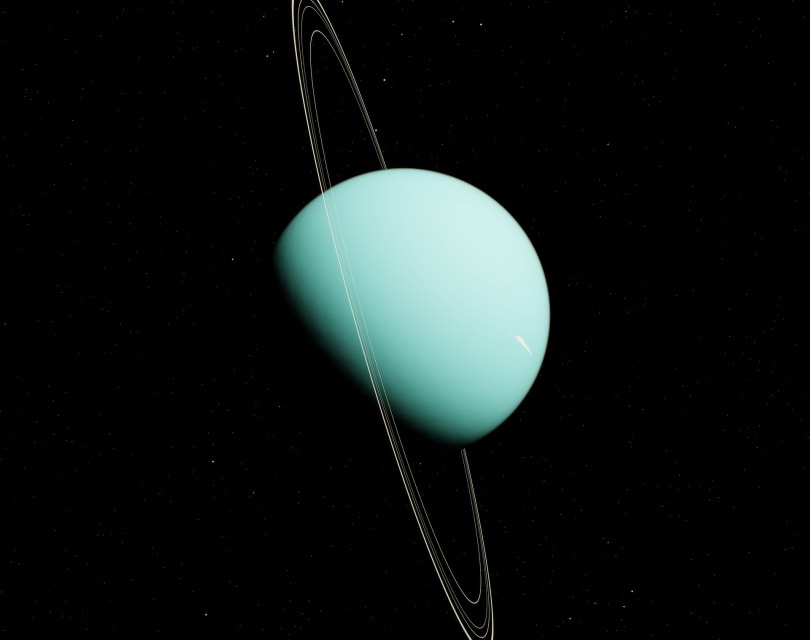
Uranus was the first planet humans found using a telescope. That was back in 1781 when astronomer William Herschel saw Uranus for the first time. Initially, he thought it was a comet or a star. It’s extremely cold and buffeted by high winds, and Uranus is the 3rd largest planet in our solar system. Its diameter is 15,759.2 miles (25,362 kilometers) around. Also, its mass is 8.68 x 1025 kg, about 14 ½ times the mass of Earth.
Along with Neptune, Uranus is one of only two “ice giants” in our solar system. Over 80% of its mass Is made up of methane, ammonia, and water. Surprisingly, the core of Uranus is about 9000 degrees Fahrenheit (approximately 5000 degrees Celsius). Although it isn’t the farthest planet from the Sun, Uranus has the coldest atmosphere of all of the planets in our solar system.

How Big Is Earth Compared to Uranus?
Uranus is significantly larger than the Earth. For comparison’s sake, if you considered that the Earth was the size of a large marble, Uranus would be approximately the size of a grapefruit. Uranus is approximately four times wider than our home planet. Also, a year on Uranus is the equivalent of approximately 84 years on Earth. That means it takes 84 years for Uranus to make a single trip around the Sun. If you were born today, for example, when you reach the ripe old age of 84, Uranus will have gone around the Sun once.
One interesting fact about Uranus is that its equator has a tilt of 97.77 degrees, which is practically a right angle to its orbit (Earth’s equator is at a 23.4-degree angle). The effect this has on the planet is to cause extreme seasonal changes. For example, for approximately 21 years (a quarter of a Uranian year), the Sun shines directly over 1/2 of the planet while the other half is completely dark and cold.
Also, while the Earth rotates from west to east, Uranus rotates from east to west. It’s only one of two planets that does this, the other one being Venus. Uranus is also the seventh planet from the Sun, whereas our planet, Earth, is the third planet from the Sun.
Uranus is about 1.8 billion miles ( 2.9 billion kilometers) away from the Sun, while the Earth is approximately 93 million miles (150 million kilometers). That means sunlight takes 2 hours and 40 minutes to reach Uranus, whereas it only takes 8 minutes and 20 seconds to reach Earth.
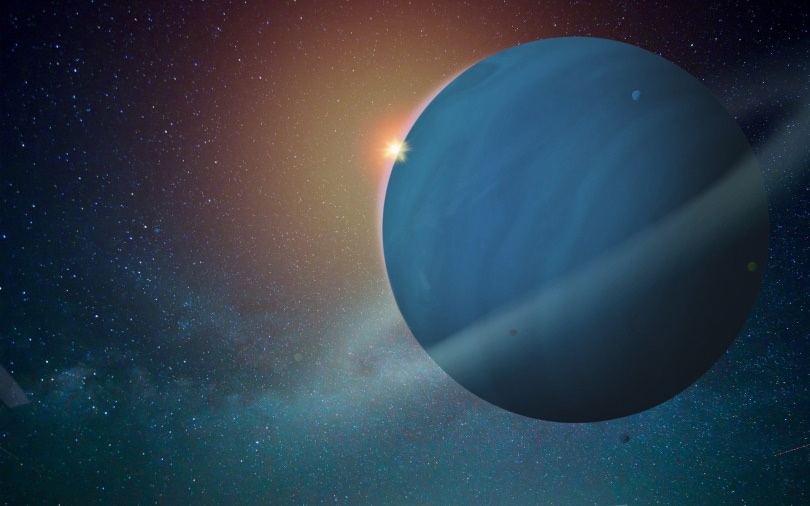
Why Is Uranus Named Uranus?
Around the year 1850, Uranus was named after the Greek deity Ouranos. This title is interesting because Uranus is the only planet to be named after a Greek instead of a Roman god. However, Herschel Walker, who discovered Uranus, was not pleased with the name. He wanted to name the planet Georgium Sidus (The Georgian Planet) after the king of England at the time, King George III. Ultimately, it was German astronomer Johan Bode who gave Uranus its name.
Can Humans Live on Uranus?
Unfortunately, no, the environment on Uranus is too extreme for human life or most forms of life. Besides the extreme environment, there are several other reasons humans could not live on Uranus. First off, the planet has no solid surface, so there would be nowhere to walk or create roads and buildings.
Some have speculated that life below the surface of Uranus may be suitable to sustain life. However, the pressure is enormous and would likely crush any life before it had the chance to begin. That same pressure would also crush any spacecraft, making it virtually impossible to explore the planet’s interior.
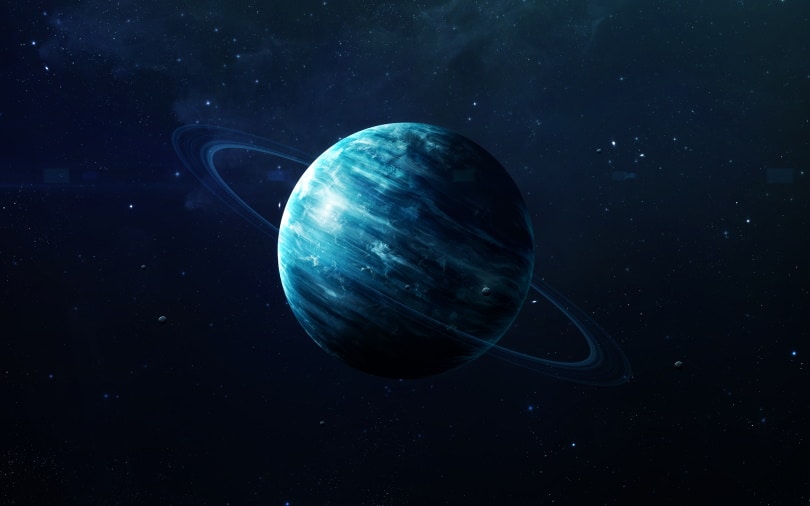
Can We Walk on Uranus?
As we mentioned earlier, Uranus doesn’t have a solid surface but is instead a big, round ball of various gases. For that reason, walking, running, or doing anything remotely physical on the planet would be impossible. Because of all the hydrogen sulfide gas clouds on Uranus, the planet would have a smell similar to rotten eggs.
Does Uranus Rain Diamonds?
While it is impossible to know if it rains diamonds on Uranus, astronomers have said it’s possible for the last 40 to 50 years. That’s due to the Voyager 2 mission from 1977, which passed by Uranus on its trip into space. The possibility has to do with the difference in pressure and temperature between the inner regions of Uranus and its outermost layers.
The intense difference between pressures can break methane molecules apart, releasing carbon. When these carbon molecules are released, they get together to form long chains anddiamond-like crystalline patterns. As they get bigger, the crystalline patterns drop back through the outermost layer and vaporize, and then the cycle repeats. They aren’t diamonds in the true sense of the word but, as hypothesized by scientists, would look like diamond rain if the process indeed occurs.
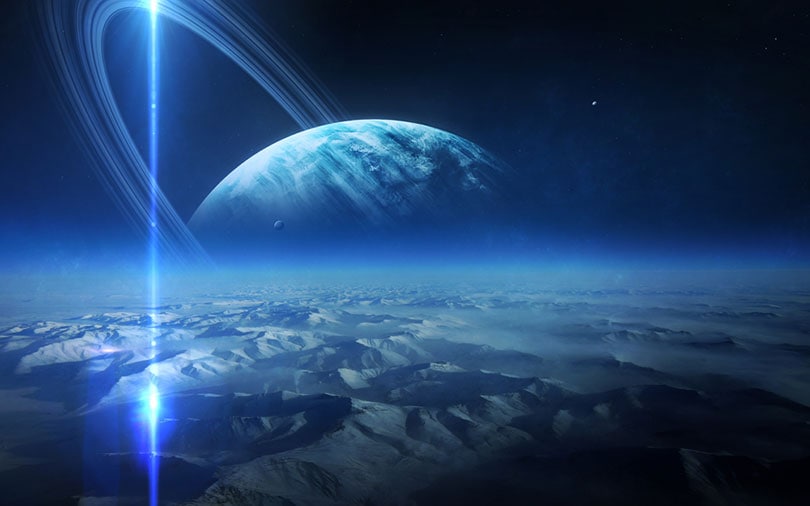
Does Uranus have Rings?
Before they the rings of Uranus were discovered, astronomers believed that Saturn was the only planet with rings. What was significant about the discovery of Uranus’ rings was that astronomers realized rings are a relatively common feature among other planets in the galaxy.
There are two sets of rings circling Uranus, including an inner system of narrow, dark rings and a much more distant system of outer rings. The outer rings are distinct in that they are red and blue.
Astronomers surmise that the rings were created by the destruction of smaller dwarf planets (similar to Pluto) that were torn apart eons ago after passing too close to Uranus. When this occurred, they were destroyed by the planet’s immense gravitational pull, leaving behind debris to form the rings. The same process also occurred on Neptune and Saturn.
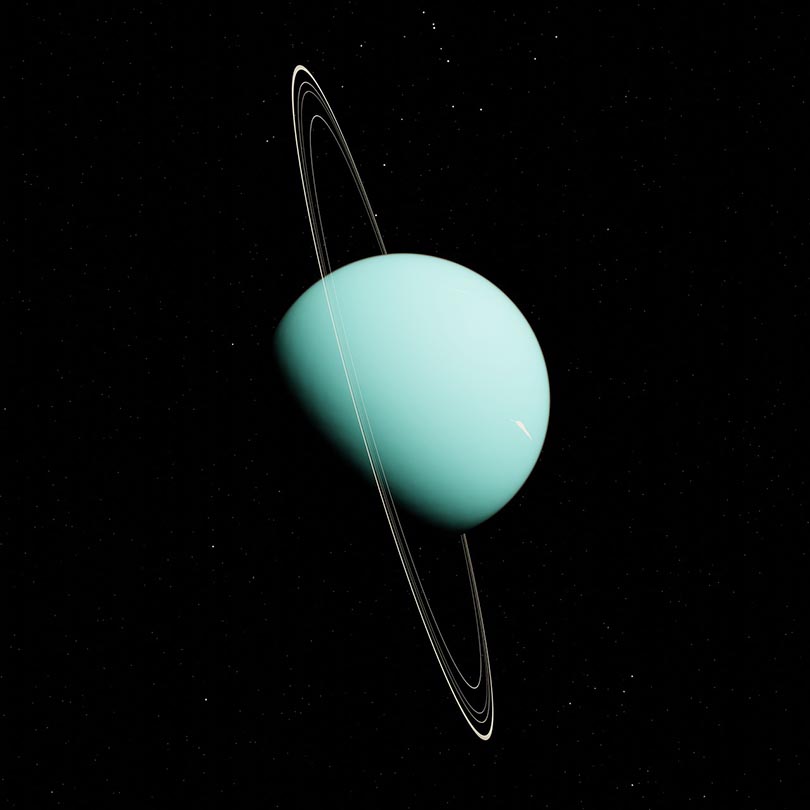
Does Uranus have Moons?
Yes, Uranus has over two dozen moons. Unlike Earth with its single Moon, Uranus has 27 of them. All of the planet’s moons are named after characters from authors William Shakespeare and Alexander Pope. This naming was a break from tradition since moons were typically named after characters in Greek and Roman mythology.
What’s truly interesting about the moons around Uranus is that, until 1948, astronomers believed the planet only had 17 of them. However, Gerard Kuiper (who discovered the Kuiper belt) found another (named Miranda) in 1948. Then, when Voyager 2 passed Uranus in 1986, 10 more moons were discovered. Most of them are incredibly small compared to the planet, from 16 to 96 miles (26 to 154 kilometers) in diameter.
Uranus also has a large collection of so-called “Trojan asteroids,” discovered in 2013. Trojan asteroids share the same orbit as a planet but aren’t moons. In fact, there are so many Trojan asteroids around Uranus that astronomers gave it a special designation called theLaGrange point. A LaGrange point is where gravitational forces between two larger bodies allow much smaller bodies to remain in a “parked” position.

Final Thoughts
Although it’s inhospitable to human life, Uranus is nonetheless a fascinating planet. As a gas giant, Uranus has no discernible surface but rather a collection of gases, including methane, that gives the plant its distinct color. It rotates backward, and the planet experiences harsh weather conditions. And, as well all know, this amazing planet is the one we love to make jokes about the most.
One last fact before we leave you today is this; the radioactive element uranium discovered just 8 years after Uranus, was named after the planet. Astronomers hope that someday soon, we will send a spacecraft to study Uranus further and unlock more of its many secrets.
See also:
- How Long Is a Day on Uranus?
- 10 Interesting Facts About Mars
- How Many Moons Does Mars Have?
- How Many Rings Does Jupiter Have?
Featured Image Credit: 95C, Pixabay
About the Author Robert Sparks
Robert’s obsession with all things optical started early in life, when his optician father would bring home prototypes for Robert to play with. Nowadays, Robert is dedicated to helping others find the right optics for their needs. His hobbies include astronomy, astrophysics, and model building. Originally from Newark, NJ, he resides in Santa Fe, New Mexico, where the nighttime skies are filled with glittering stars.
Related Articles:
How to Collimate Binoculars: 9 Expert Tips
How to Clean a Refractor Telescope: Step-by-Step Guide
How to Clean a Telescope Eyepiece: Step-by-Step Guide
How to Clean a Rifle Scope: 8 Expert Tips
Can You Use Binoculars to Look At Stars? How to Choose the Right Pair
How to Choose Binoculars for Bird Watching: 10 Expert Tips
15 Crucial Facts About Ultraviolet Rays & the Sun
What Constellation Is Spica In? The Interesting Answer!
